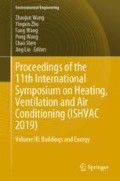Abstract
Building energy monitoring system is an effective measure to provide the energy consumption information in large-scale public buildings. However, in actual operation process, many errors may occur in the existing measurement due to the low accuracy of the instruments and mistakes in human operation. This study proposed a novel method to improve the accuracy of power monitoring data at a low instrument cost. In this method, two sets of comparative data, obtained by conventional and high-precision instruments, respectively, were measured on a self-designed test rig. The changes of the relative differences between the two sets of data were quantitatively studied considering three factors, including load rate, cable cross-sectional area, and its length on the secondary side. The results show that the measurements should be carried out under recommended conditions in engineering applications when the load rate is at more than 20%, the cable cross-sectional area at 4 mm2, and the length of cables less than 50 m. The method proposed in this study can effectively achieve the accuracy of energy consumption data through background processing based on the existing ammeters in large public buildings.
Access this chapter
Tax calculation will be finalised at checkout
Purchases are for personal use only
References
Luo, M.H.: Analysis of potential, characteristics and driving force of energy-saving reconstruction in large-scale public buildings. Urban Constr. Theory Res. (13) (2011)
Xu, Q., Zhi, J.J., et al.: Energy consumption data analysis of Shanghai public building energy consumption surveillance platform. Shanghai Energy Conserv. 6, 317–321 (2017)
Ferreira, V., Fleming, P.: The use of sub-hourly primary meter data to identify electricity savings in municipal buildings. Energ. Effi. 7(5), 879–889 (2014)
Li, X., Bowers, C., et al.: Classification of energy consumption in buildings with outlier detection. IEEE Trans. Industr. Electron. 57(11), 3639–3644 (2010)
Seem, J.: Using intelligent data analysis to detect abnormal energy consumption in buildings. Energy Build. 39(1), 52–58 (2007)
Dodier, R., Kreider, J.: Detecting whole building energy problems. ASHRAE Trans. 1, 579–589 (1999)
Motegi, N., Piette, M.A., et al: Case studies of energy information systems and related technology: operational practices, costs, and benefits. Texas A & M University (2003)
Wang, Z., Srinivasan, R.S.: A review of artificial intelligence based buildings energy use prediction: contrasting the capabilities of single and ensemble prediction models. Renew. Sustain. Energy Rev. 75, 796–808 (2017)
Chen, L., Tu, S.C.: Common problems and methods of sub-metering data quality. Constr. Sci. Technol. 14, 84–85 (2016)
Wu, W.Q.: Identification and repair method of building energy consumption monitoring data based on machine learning algorithm. Constr. Sci. Technol. 9, 60–62 (2017)
Acknowledgements
The project is supported by the National Key R&D Program of China (Number 2017YFC0704206).
Author information
Authors and Affiliations
Corresponding author
Editor information
Editors and Affiliations
Rights and permissions
Copyright information
© 2020 Springer Nature Singapore Pte Ltd.
About this paper
Cite this paper
Wu, J., Zheng, Z., Lian, Z., Lai, D. (2020). Principal Factors Affecting the Accuracy of Real-Time Power Monitoring Data in Large Public Buildings. In: Wang, Z., Zhu, Y., Wang, F., Wang, P., Shen, C., Liu, J. (eds) Proceedings of the 11th International Symposium on Heating, Ventilation and Air Conditioning (ISHVAC 2019). ISHVAC 2019. Environmental Science and Engineering(). Springer, Singapore. https://doi.org/10.1007/978-981-13-9528-4_29
Download citation
DOI: https://doi.org/10.1007/978-981-13-9528-4_29
Published:
Publisher Name: Springer, Singapore
Print ISBN: 978-981-13-9527-7
Online ISBN: 978-981-13-9528-4
eBook Packages: Earth and Environmental ScienceEarth and Environmental Science (R0)

